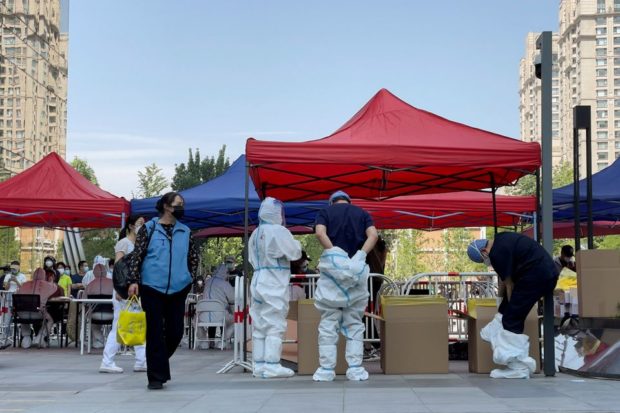
Workers remove their protective suits at a makeshift nucleic acid testing site during a mass testing for the coronavirus disease (COVID-19) in Chaoyang district of Beijing, China May 3, 2022. REUTERS
SHANGHAI/BEIJING — Some of Shanghai’s 25 million people came out for brief walks and grocery shopping on Tuesday after enduring more than a month under a COVID lockdown, while China’s capital Beijing embarked on another round of mass testing to control a nascent outbreak.
Social media posts showed Shanghai residents strolling in their suburbs, or queuing up at supermarkets that had been allowed to reopen. One picture showed two women carrying a pole with four bulky bags of groceries on their shoulders.
That was the result of an incremental easing of curbs in five of the city’s 16 districts from Sunday, home to about a fifth of Shanghai’s population, where some people were allowed to leave their housing compounds for the first time in weeks.
The level of the restrictions varied from one residential complex to another. In many compounds, a single person from each household could go out at a time, for a maximum three hours.
Most do not get permission to drive or even ride a bike, prompting jokes on social media.
One WeChat page used to organise group orders for basic necessities during the lockdown listed a donkey priced at 88,888 yuan ($13,450) with a delivery date set after 365 years as an alternative to using vehicles to transport groceries.
“Please count me in for one of those donkey group buys,” one resident commented to the post.
In China, the number eight is associated with prosperity.
Increasingly out of step with most other countries which have significantly eased or even completely lifted coronavirus restrictions, China has given no hint of deviating from its “zero COVID” policy.
China has accepted a heavy economic cost and demanded huge personal sacrifices from millions forced into prolonged isolation.
Many of these people have struggled with lost income, difficulty sourcing food and severe delays in access to emergency healthcare and other basic services. This has led to rare outbursts of anger in a sensitive year for President Xi Jinping, who is widely expected to secure a precedent-breaking third leadership term this fall.
Chinese authorities say their COVID policies aim to save as many lives as possible, pointing to the millions of deaths COVID has caused outside China.
Authorities reported 20 new COVID deaths on May 2, all in Shanghai, taking China’s total to 5,112 since the pandemic began.
Beijing, with dozens of new cases daily in an outbreak in its second week, is banking on mass testing to locate and isolate infections and avert a Shanghai-like lockdown.
The capital of 22 million tightened COVID curbs over the five-day Labor Day holiday that runs through Wednesday, traditionally one the busiest periods for restaurants and tourism.
Twelve out of 16 Beijing districts will carry out a further three rounds of COVID tests between May 3 and 5, following three previous rounds of screening last week.
The capital’s restaurants were closed for dining in and some apartment blocks were sealed shut. Most other venues were either closed, or demanded a negative PCR test from visitors.
Streets were quiet, with many residents fearing they might receive a quarantine order if found to have been in the proximity of a COVID case.
Beijing’s new daily cases have been relatively steady since the first infections in the capital emerged on April 22, with a total of 62 detected on May 2.
In Shanghai, the number of cases found outside quarantined areas was up to 73 from 58 – a setback after two consecutive days of zero such cases.
A period of zero cases in such areas, where some movement outside residential compounds is allowed, is a key requirement for a more significant relaxation of COVID curbs.
($1 = 6.6080 Chinese yuan renminbi)
RELATED STORIES
Setback for Shanghai’s COVID-19 battle; Beijing focuses on mass testing
China COVID-19 hard line eats into everything from Teslas to tacos
Beijing firms up COVID-19 screening to prevent Shanghai-like chaos
China’s COVID-19 death toll rises as Beijing warns of ‘grim’ situation